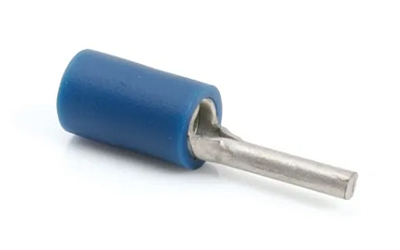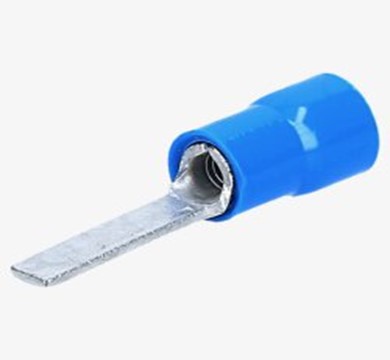Electrical and electronic equipment requires cables for their power supply, power distribution, interconnections, control, monitoring and so on. Some of the equipment which comes to our mind include electrical appliances, electrical load switches, circuit-breakers, fuse bases, electrical motors, generators, transformers, busbars and electrical control and distribution panels, to name a few. Besides, a host of mechanical equipment also require cables for their electrical systems which involve controlling, monitoring, and electrical power supply. Wherever electricity is used, cabling with cable terminals becomes a necessity. These cable connections are therefore critical and demand that they are sturdy, secure and safe, and this is ensured through Cable Terminals.
What are Cable Terminals?
A Cable terminal, also known as a Cable Lug is commonly defined as a fixture, which is installed on the end of a cable (or wire or conductor) to ensure that the cable is properly connected to a device, system or equipment.
Cable terminals, besides helping in the passage of current, connect cables to various pieces of equipment. Thereby they create sturdy and secure connections using which electrical systems are linked together.
Without the usage of cable terminals, it is extremely difficult to rely on the cable connections in an electrical system, unless, of course, some permanent method is used, such as soldering. Improper and poor cable connections result in high resistance at the joints, leading to their overheating, flashover or short circuit and fire hazards. These terminals form a crucial factor while designing, constructing, maintaining, repairing, and replacing parts of an electrical system. Also, when properly selected and used, they ensure reliability over a long period.
Cable Terminals are essentially used for cable connections in electrical systems, equipment and devices. They are designed to accommodate a wide range of cable sizes including cables with large cross sections. They are designed to be durable so that they can support the cable weight and carry large currents of the cables for which they are designed.
The most commonly used Cable Terminals are either made from copper or aluminium, or their respective alloys (i.e., alloy of copper or alloy of aluminium).
Here we will dwell upon cable Terminals – their types, uses, their international standards.
Copper Cable Terminals
Copper Cable Terminals inherently possess the high conductivity of copper, offer easy installation and are durable. These terminals are composed of premium ETP Copper materials and are tin-plated for added protection against corrosion. They are particularly beneficial for outdoor applications or usage within marine environments.
Talk to our engineers!
Aluminium Cable Terminals
Aluminium Cable Terminals are manufactured from high-grade aluminium and are lighter and less expensive as compared to copper cable Terminals. Aluminium Cable Terminals with Aluminium Cables are very cost-effective and therefore find wide use.
Watch our video to understand in more detail:
Tinned Copper Cable Terminals
Tin-plated Copper Terminals, commonly known as tinned copper terminals, they offer resistance against corrosion caused by harsh environments. Tinned copper is primarily used for protection against oxidation and corrosion. Tin acts as an extra layer of protection against corrosion, oxidization, and the damaging impact of high temperatures. These Terminals are ideal for large-scale applications in electrical power systems and grounding systems. The main disadvantage of Tin as a metal finishing process is that it is unsuitable for use at high temperatures (about 200 degrees Celsius).
Bimetallic Cable Terminals
When two dissimilar metals come in contact with each other, it causes a ‘dissimilar metal’ corrosion or ‘galvanic action’, i.e., a conductive path is created for electrons and ions to move from one metal to the other. This causes one metal to corrode as its ions are deposited onto the other metal. For instance, such a possibility can arise when:
- Aluminium cables are terminated on copper busbars
- Aluminium cables are ‘capped’ with copper terminals
Here the aluminium cable and the copper lug barrel, being two different metals, result in the occurrence of galvanic action. Therefore, Bimetallic Terminals are used to prevent such dissimilar contact. These Terminals are constructed by joining a forged copper palm to an aluminium barrel using a solid-state welding process known as friction welding. These terminals thereby avoid their galvanic corrosion and have a sturdy and durable joint.
In Bimetallic Terminals, the aluminium barrel will accommodate and be in contact with the aluminium cable, while the flat copper palm will be in contact with the copper busbar. The copper palm is provided with a hole so that it can be bolted to the copper busbar. Bimetallic Terminals find extensive use in cabling for switchgear panels, distribution boxes (commonly known as combiner boxes) for solar plants and other electrical systems. The types of Cable Terminals which we commonly come across are:
- Ring type Terminals
- Pin type Terminals
- Fork type or ‘U’ type Terminals
- Flat type Terminals
Ring Type Terminals

Ring Type Terminals are terminals that join cables or wiring to a stud or screw connection. One end of the ring terminal is equipped with a closed or open crimp barrel to make an electrical connection with the cable. These cable Terminals are manufactured from high grade copper which has high conductivity & high purity. Ring type terminals are reliable and are used where there is less chance to remove the terminals from a terminal block due to their ring shape.
These Terminals are available in different types, such as, insulated, non-insulated, and metal reinforced. Ring types Terminals are widely used for wiring terminations in houses, buildings, switchgear panels, and other electrical devices. These Terminals are reliable and secure because of their shape their chances of slipping out from terminal blocks are very low.
Pin Type Terminals

Pin type terminals are used for industrial and commercial applications. They are tubular and built of lightweight aluminium with brass pin-lug nuts for durability. Pin Type Terminals are sturdy and reliable. They are designed for terminating cables into terminal blocks. The reduced pin makes these terminals ideal for terminating conductors into contact block applications.
These terminals are mainly used in industrial sectors for the connection of cables to relays and other electrical instruments. It is easy to connect due to the ‘I’ shape. It is used in low voltage levels and for control and indication cables.
Fork Type (or ‘U’ type) Terminals
Fork Type Terminals are similar to ring type terminals, except that they are ‘U’ shaped and are designed for quick and easy connection and disconnection.
In some situations, while disconnecting a wire it is very difficult to remove a nut from a stud, or there is very little space to work in. In such situations, fork type terminals are found to be a very good option. Whereas ring type terminals need to slide over the stud, fork type terminals only need to hug the stud. Thus, fork type terminals can be installed without having to completely remove the nut from a stud. One has to just loosen the nut partially, slide the fork type lug behind the nut and retighten it. This is advantageous especially where a bus bar stud has several wires already attached to it; one need not remove any wire or device to provide space for the additional terminals.
Fork type terminals are generally used for the connection of devices like MCBs, switches, relays and other electrical instruments.
Flat Type Terminals

Flat Type Terminals, similar to pin type are also ‘I’ shaped. As the name suggests, they are flat shaped, whereas Pin type Terminals are tube shaped. Flat types are also commonly used for low voltage control wiring.
International Standards for Cable Terminals
Cable Terminals form a very critical part in electrical connections, and therefore it is important that they be certified by reputed international bodies. The certification is based on the design, material, construction and tests conducted on the cable terminals. These are defined by the standards laid down by IEC (International Electro-technical Commission), UL (Underwriters Laboratories) and DIN (German Institute for Standardisation).
Following are the international standards as applicable for cable terminals.
IEC 61238-1
- The standard applies to the electrical and mechanical properties of power cable connectors.
- The electrical and mechanical tests to be carried out are defined in this IEC standard document.
UL310 and UL 486A 486B
- This standard evaluates the safety of cable connectors and compliance with the standard.
- It defines the electrical and mechanical tests to be carried out for the purpose.
DIN 46235, 57295
- This standard defines the application, dimensions, and marking of cable terminals.
- The standard also provides guidelines for selecting the right cable Terminals for various types of conductors and cables.
Conclusion
Cable Terminals, based on their type and material composition (i.e. copper, aluminium, alloys of copper and aluminium), find a wide variety of use in cabling and wiring terminations.
The various types of cable Terminals and their uses are mentioned above. They are used in cabling and wiring in houses, buildings, electrical equipment, distribution boards, switchgear panels, electrical control desks, industries, substations, road lighting, electrical appliances, electrical systems, solar plants, and the list can go on. In fact cable Terminals are complimentary to cabling.
Copper cable terminals inherently possess the high conductivity of copper, offer easy installation and are durable. Aluminium cable terminals with aluminum cables are very cost effective and therefore find wide use. Tin plated copper terminals, commonly known as tinned copper terminals, offer resistance against corrosion caused by harsh environments. Bimetallic Terminals find extensive use in cabling for switchgear panels, distribution boxes (commonly known as combiner boxes) for solar plants and other electrical systems.
Though these terminals form a very small part, both size wise and cost wise, in electrical systems and equipment, they are extremely critical. They are pivital while designing, constructing, maintaining, repairing, or replacing parts of an electrical system Cable Terminals form an important part in an electrical system for passage of current. Proper selection of cable Terminals is very important which depends on factors like:
- Cable size, material and type
- Load current
- How much weight the Cable terminal needs to handle
- Ambient or environmental conditions (like temperature, corrosive environment, etc.)
Improper selection or installation of cable terminals cause overheating at their terminations, leading to electrical short circuit and fire hazards. Cable terminals, when properly selected and installed, ensure reliability over a long period by ensuring that they can withstand harsh environmental conditions. Unfortunately, there are many instances when no importance is given to cable terminations; oversized terminals are used to cause loose cable terminations while undersized cables are either forced into the terminals or cable strands are cut to make them fit into the terminals. Both these methods are most likely to cause fire hazards due to overheating or short circuits at these cable terminations.
For more information, please contact us at axis-india.com/contact-us/








